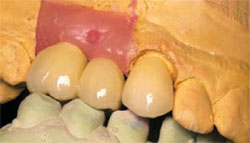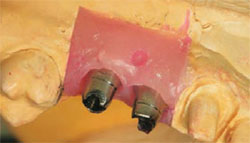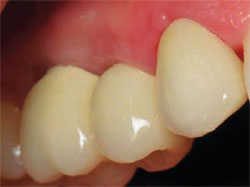A “SIMPL” Protocol for Restoring Implants
When confronted with a single missing tooth, does your treatment plan veer toward a traditional three-unit bridge rather than a single-tooth implant? Do you feel that implants are too complex for your practice? Do the different manufacturer systems seem confusing?
According to one survey, 78% of the general dentists’ involvement in implant dentistry has increased in the last 2 years, but 73% of dentists only perform one to three cases per month. Set-up costs, parts, laboratory costs, and a disparity among manufacturers are cited as reasons why they do not perform more implant dentisty.1
Today, more than ever before, dentists need to become aware of the many advances that have made restoring implants as easy as, if not easier than, traditional crown-and-bridges. For these reasons and more, Town & Country Dental Studios created a system that makes restoring implants “SIMPL.”
A SIMPL Overview
The SIMPL™ Implant Abutment System (Town & Country Dental Studios, Freeport, NY) is a combination of superior products and simple steps that make the restorative process easier for both the surgeon and the general dentist. First, SIMPL requires only a fixture-level impression with transfer copings, a counter, and bite; no other parts are needed. Second, SIMPL features a precision-milled computer-aided design/computer-aided manufactured (CAD/CAM) abutment from Atlantis Components, Inc (Cambridge, MA). Atlantis CAD/CAM abutments are guaranteed to provide a better clinical result than stock abutments, and their limited warranty covers the implant fixture regardless of manufacturer. Lastly, a simplified clinical approach and one-fee pricing saves a tremendous amount of planning time, preparation time, and chairtime.
Why use CAD/CAM abutments?
Unlike stock and custom-cast abutments, both of which are prone to fit and function issues, CAD/CAM abutments are milled by computer directly from a solid block of either medical-grade titanium or tooth-colored zirconia, which makes them extremely strong, morphologically correct, and highly esthetic. To create the abutment, the working model is scanned optically to generate exact 3-dimensional images of the region. Once scanned, innovative computer software designs the perfect abutment with an ideal margin for optimum esthetics. Normally the default margin settings are 1 mm subgingival on the facial?buccal, 0.75 mm subgingival interproximally, and 0.5 mm subgingival on the lingual?palatal. The designs for contact areas are ovoid and located 5 mm above the bone. Chamfer margins are placed to allow room for fabricating an esthetic restoration, and retention and resistance principles are integrated into the design. When appropriate, the dentist can even give input into the design of the abutments.
What is the “SIMPL” system?
In response to many dentists’ concerns and confusion about the costs of parts and laboratory fees, Town and Country Dental Studios developed the SIMPL Implant Abutment System, which has made estimating cost quite simple. SIMPL includes a titanium CAD/CAM abutment, a titanium abutment screw, an abutment placement jig, an analog, and soft tissue model. To this is added the desired restoration, including high-noble porcelain-fused-to-metal, Lava™ (3M™ ESPE™ , St. Paul, MN), Procera® (Nobel Biocare, Yorba Linda, CA), Empress® (Ivoclar Vivadent, Amherst, NY), Captek™ (Precious Chemicals, Inc, Altamonte Springs, FL), or others. The fixed fee associated with the SIMPL system makes a single-unit implant comparable to the cost of a conventional three-unit bridge, and more palatable to the patient. By using the SIMPL system, the dentist can immediately understand the profit of a case by knowing exactly what the laboratory costs are beforehand.
A SIMPL Case Study
Approximately 2 weeks after uncovering the implants and placing the healing abutments, the patient was referred back to the restoring dentist by the surgeon for fixture placement. The first step taken by the restoring dentist was to remove the healing abutments. He then placed the transfer copings and verified them via radiograph. A fixture-level impression was taken (using an open or closed tray) as well as a counter and bite. All of these were sent to Town & Country Dental Studios. The healing abutment was replaced and the patient was dismissed. Total chairtime was 15 minutes; total dentist time was 10 minutes.
In 10 business days, Town & Country returned the completed SIMPL case to the restoring dentist. Included were the CAD/CAM abutments, the abutment screws, the analogs, the soft-tissue model, the SIMPL abutment placement jig, and the restoration of choice (Figure 1). The SIMPL CAD/CAM was returned to the office, numbered, in position, and placed on a soft tissue model (Figure 2).
For accurate placement without any rotation, SIMPL provides an implant abutment placement jig (Figure 3), which is especially useful in helping place multiple abutments and when placing in difficult access areas such as the second molar area.
The healing abutment was removed and the SIMPL abutment was placed with the use of the placement jig. The abutment was torqued down to the manufacturer’s recommendation and verified by radiograph (Figure 4). The final restoration was cemented (Figure 5). Because the crown was fabricated directly on the abutment without the use of stone or metal dies, the fit was excellent and adjustments were almost nonexistent. Total chairtime was 15 minutes; total dentist time was 10 minutes.
Conclusion
Town & Country Dental Studios has created SIMPL, a cost-effective implant restorative protocol that uses cutting-edge technology to deliver a better result, regardless of the dentist’s experience or case complexity. SIMPL provides significant advantages over stock and custom cast abutments, and the clinical technique requires only a fixture level impression with transfer copings, counter, and bite.
References
1. Implant survey 2003. Dental Products Report. January 2004. Available at: https: //www.dentalproducts.net/xml/display.asp?file=2174. Accessed July 7, 2006.This article was written by Dr. Steven Glassman, New York, New York. Figures were provided by Dr. Glassman.
For More Information
Town & Country Dental Studios
Web: www.SimplAbutments.com
Phone: 800-925-8696
 |  | |
| Figure 1 The complete SIMPL case, including the CAD/CAM abutment, abutment screws, analogs, the soft-tissue model, the SIMPL abutment placement jig, and the restoration. | Figure 2 The SIMPL CAD/CAM abutment placed on a soft-tissue model. | |
 | ||
| Figure 3 The implant abutment placement jig. | ||
 |  | |
| Figure 4 A radiograph of the placed abutments. | Figure 5 The final restoration. |



